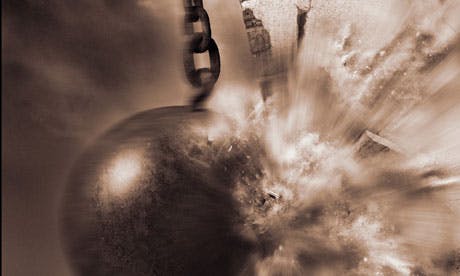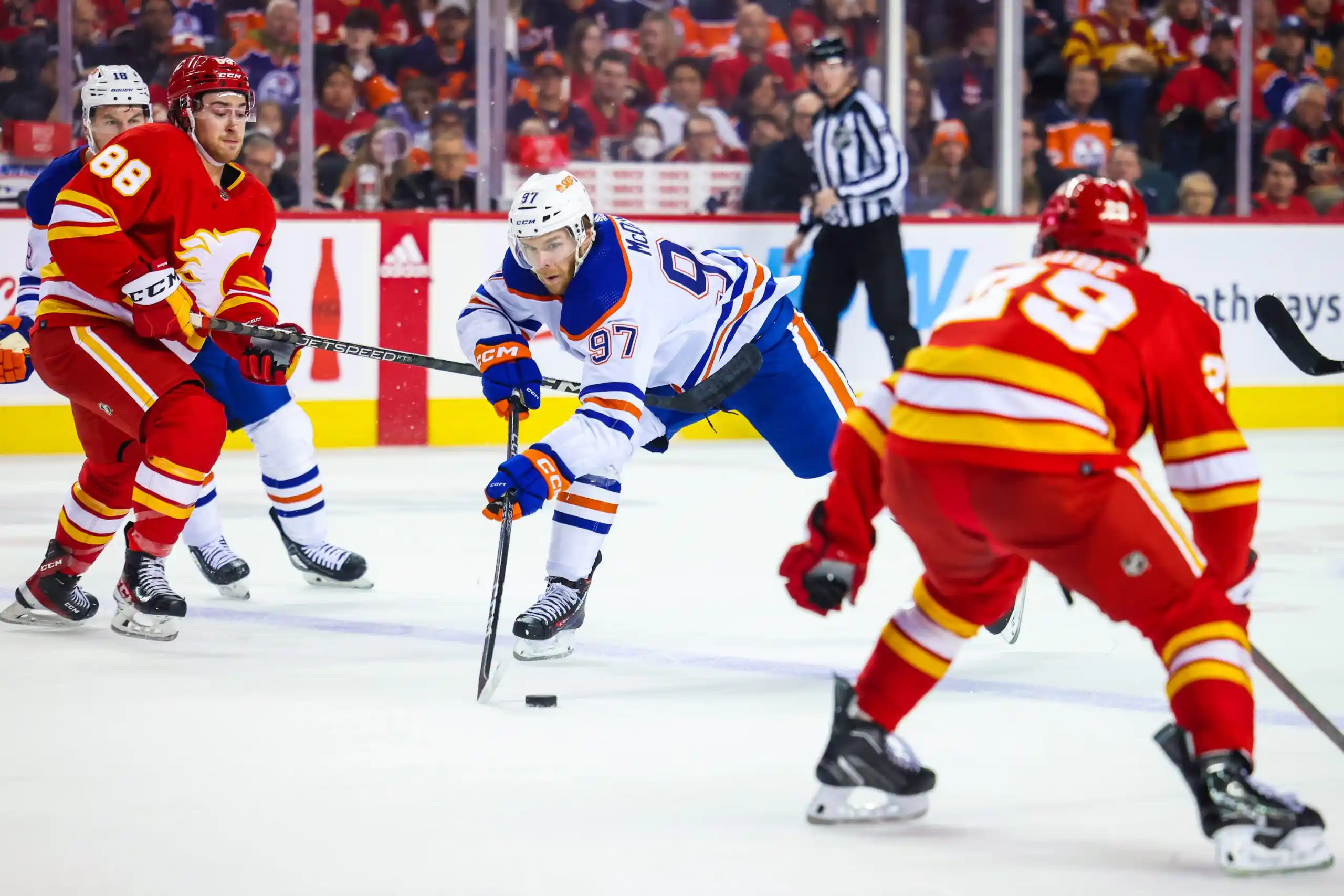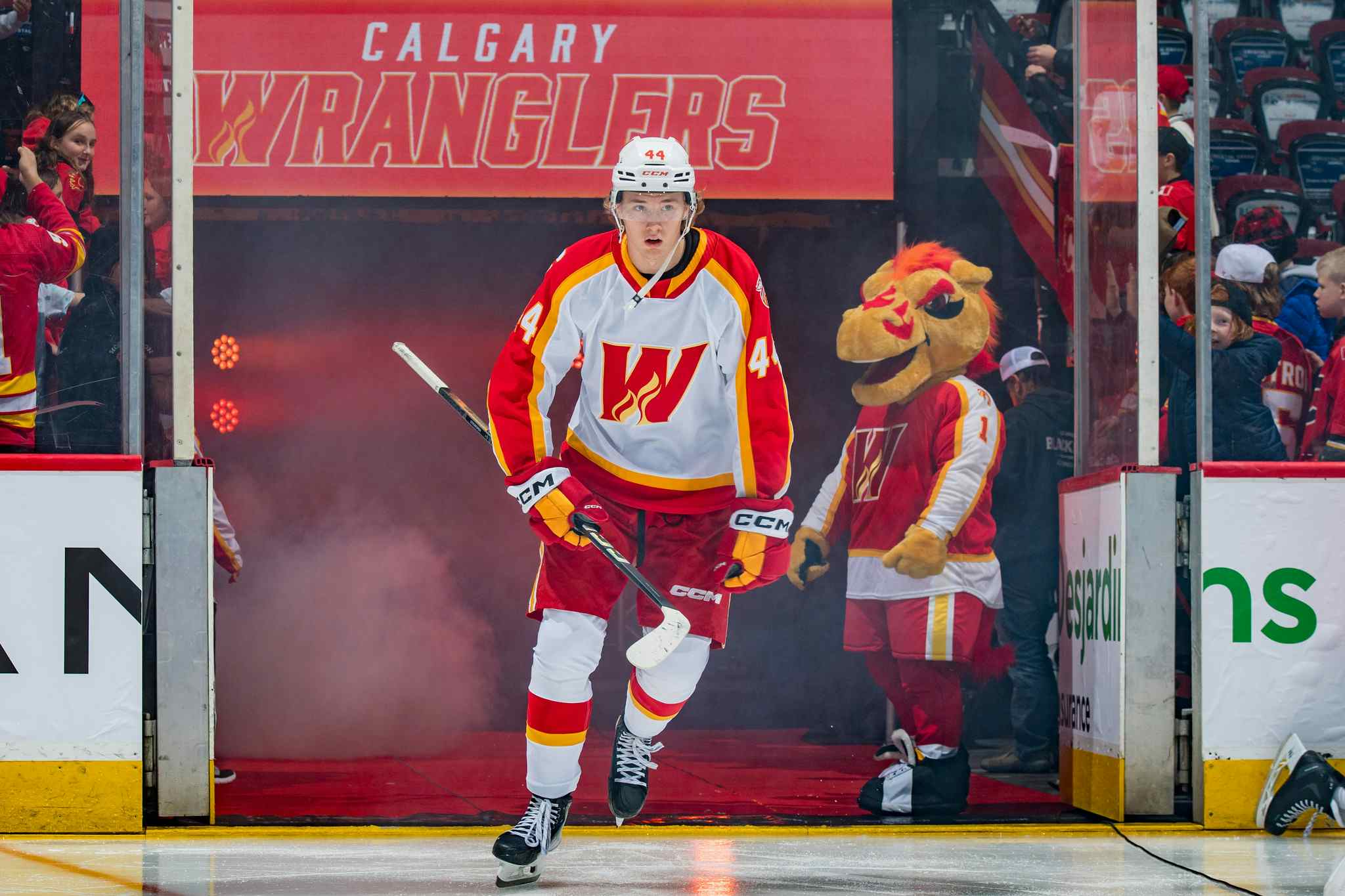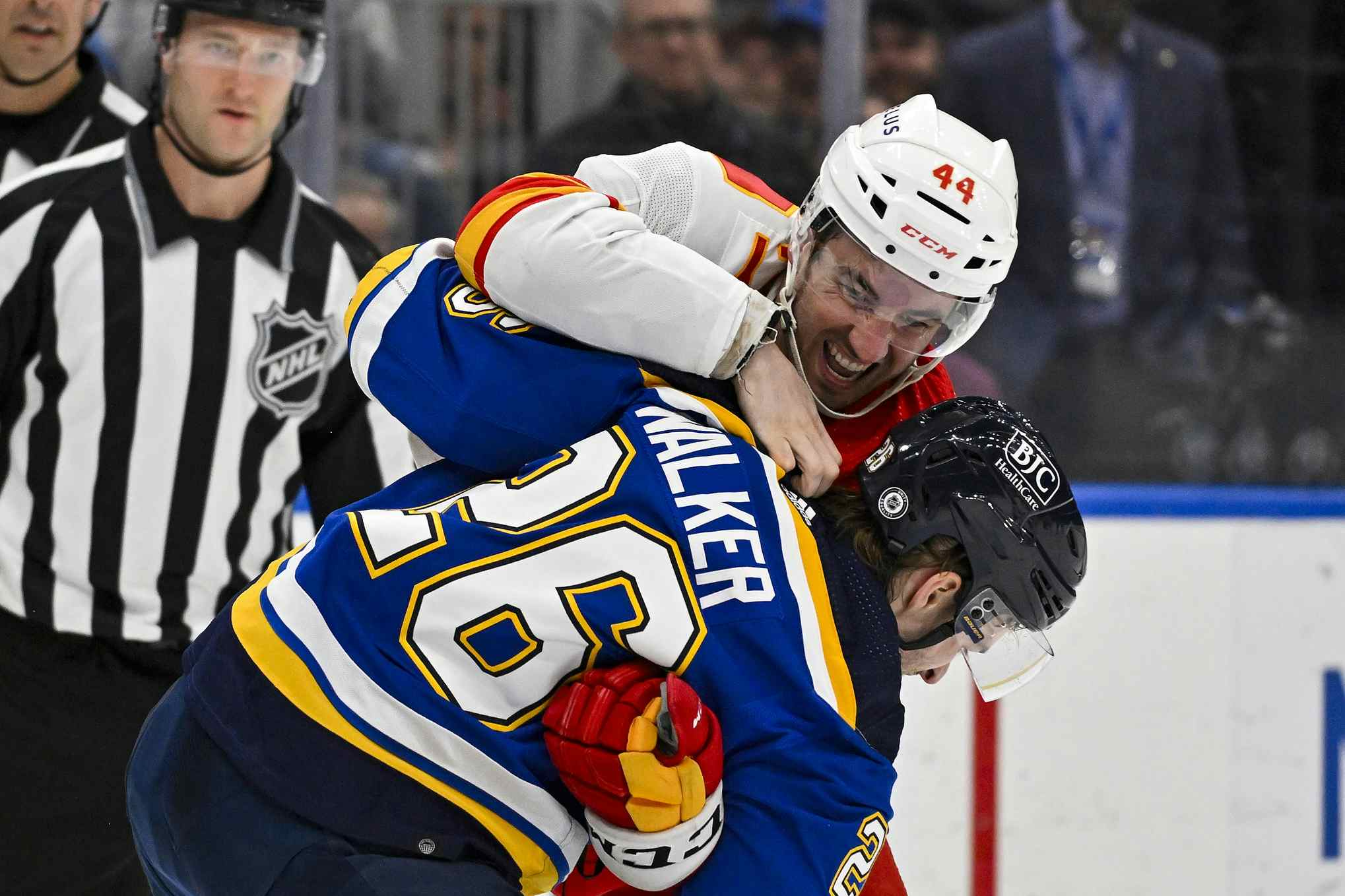Flames 2013-14 Season preview – Creative Destruction
By Kent Wilson
10 years ago
After four years of teetering on the edge of the precipice, the Flames finally plunged head first into the abyss. The only pertinent question for the club now is how deep the hole goes.
last year, the season preview was titled battling the inevitable. Thanks to a confluence of circumstances – Iginla’s pending free agency, the implosion of the goaltending, bad luck, bad roster construction – Calgary finally, inexorably, lost the battle and the organization was forced to finally do what so many fans and pundits had been suggesting for so long – begin the rebuild.
The irony is, the Flames probably weren’t as bad as their results suggested in 2012-13. Calgary suffered through the worst puck-stopping in the league thanks to Kipper finally bowing to the ravages of time as well as the club’s terrible depth in net behind him. The Flames still suffered from all of the issues that dogged them for the last three prior seasons – an expensive, aging top-end that was no longer elite and a complete lack of peak age talent – but with league average goaltending they nevertheless would have been at least been solidly middling once again. No doubt that would have led to some difficult (or delayed) decisions regarding Jarome Iginla Miikka Kiprusoff, which perhaps would have further extended the wait to "blow it up" at least one more season.
Instead, the crease brigade imploded and the Flames were well out of the running by the trade deadline which forced Feaster to finally auction off Jarome Iginla and Jay Bouwmeester. Calgary’s underlying numbers fell apart shortly thereafter as the veterans were traded or fell to injury and the team attempted to lose down the stretch. It didn’t get them in the top-5 at the draft, unfortunately, but there’s still plenty of time for that.
The Forwards
Out: Jarome Iginla, Alex Tanguay, Roman Cervenka, Steve Begin
In: David Jones, TJ Galiardi, Sean Monahan, Corban Knight, Joe Colborne
Gone are Iginla, Blake Comeau and Alex Tanguay, all via trade. Ill-fated experiment Roamn Cervenka fled back to the KHL this summer after struggling to keep up with the defensive aspects of the game on North American ice. Instead, the team will skate with David Jones, acquired in the Tanguay trade (when it was clear Alex had no interest sticking around for a rebuild) and native Calgarian TJ Galiardi, garnered from the Sharks for a 4th round pick. Both guys are capable middle tier forwards, but neither is going to answer the Flames greatest need: elite level talent. Of which there is precisely none on this club.
Rookie Sven Baertschi and new top prospect and 6th overall pick Sean Monahan might develop into high level guys one day, but neither is there yet. The former will get a lot of chances to find his stride with the parent club this season after bouncing around the NHL and AHL last year. Baertschi is the best pure offensive forward in the organization’s pro ranks currently, but his game needs refinement and development at the highest level. At just 21 years old there’s a lot of room for improvement in Baertschi’s intensity and decision making in all areas of the ice, although there are some fans who expect him to challenge for the team scoring lead right away. The truth is he’s optimistically two years away from being a high impact player at this level.
Monahan is just 18 years old and will get a 9-game cup of coffee with the Flames, because newly rebuilding teams can almost never resist showing of their shiniest new bauble. Monahan is a potentially elite two-way center, but like Baertschi isn’t going to dominate the proceedings just yet.
The rest of the line-up is more or less unchanged. Lee Stempniak, Curtis Glencross and Maat Stajan will start the year as the league’s most roundly dismissed (but probably underrated) first line. All three guys are quality players of varying degrees and if they formed Calgary’s third line at even strength, the club would be a power house rather than a weak sister. Alas. Look for pending UFA’s Stempniak and Stajan to be flipped at the deadline.
Probable second-line Mikael Backlund is entering a pivotal season with the team. Re-signed to a one-year "prove it" deal this past summer, Backlund has some of the best underlying numbers on the squad, but will have to remain healthy and spike those results with some offensive finish if he’s to stick around long term. At 24, Backlund is one of the very few current Flames close to peak age iand with a bit more scoring he could become a two-way force around which the rest of the resurgent roster can be built around.
Calgary rounds out its top-six depth with 45-50 point guy Jiri Hudler (who is no doubt looking for a back door out of this situation) and Mike Cammalleri. The latter will be the team’s lone, remaining big gun from days gone by. Cammalleri is still an effective triggerman, but isn’t a talent who is going to singlehandedly right the ship. Management will no doubt look to pump his value as much as possible before auctioning him to the highest bidder at the deadline.
At the bottom end of the rotation is Galiaradi, Jones, tough guy Jackman, potential checker Lance Bouma and facepuncher Brian McGrattan. On the edges of the roster are hopefuls Roman Horak, Corban Knight, Joe Colborne and Max Reinhart, all of whom will likely get looks when injuries and trades cull the big club’s roster. Knight, at 23 years old, was a quality college player and high-end Florida prospect acquired in the summer. He was expected to press for a spot out of training camp, but it became in pre-season clear he’ll need at least some seasoning in the minors.
The recently acquired 6’5" pivot Joe Colborne has the potential to be quality 2nd or 3rd line center, but will need to work his way up the depth chart and stave off challenges by other hopefuls in order to stay in the rotation. If Colborne can play, look for him to take over for Sean Monahan on the active roster beyond the 9-game mark, which is when the team will have to decide whether to keep the kid and burn a year of his ELC or send him back to junior.
Overall, the Flames have enough talent and depth that they won’t be routinely run out of the rink, assuming they get the bounces. There’s zero established elite possession or scoring talents, and no one is poised to become elite this season either. The depth is also precarious given the lack of top-end ability – one or two injuries to or trades of players in the top-6 and things get thin in a big hurry for Calgary. Some kids are bound to get a lot of at bats on the big team this year as a result, which isn’t necessarily a bad thing since 2013-14 is a fact finding mission for the club and not a search for the holy grail.
The Defense
Out: Jay Bouwmeester, Cory Sarich
In: Shane O’Brien, Kris Russell
The Flames blueline, like it’s forwards corps, features some good players, but zero elite talents and the depth gets scary as soon as you get beyond the top of the rotation. TJ Brodie is perhaps the best story to emerge out of the club’s fall from grace over the last 12 months or so and should be firmly ensconced in the top-4 group, if not the top-2 pairing. A high-end puck mover Brodie, like Backlund, will have to further prove he’s the sort of talent the team will be able to start assembling a new core around by continuing to develop and improve.
New captain Mark Giordano and Dennis Wideman round out the top-3, although both would probably be number four guys on a contender. Cory Sarich was replaced by Shane O’Brien in the Tanguay trade, and the move probably won’t make much difference either way. Kris Russell lands in Calgary, his third NHL stop despite being just 26 years old. A second round pick by Columbus, Russell made the NHL at 20 years old and was tabbed to be a high-end offensive producer after tearing up junior, but never managed to take thet step in the NHL. His best output in the NHL is just a 23-point season in 2010-11. Russell is quick and mobile, but small and can struggle with containing bigger opponents. His underlying numbers have been mediocre forever.
Beyond Russell is Chris Butler, who may have been the worst veteran defender in the league last year, tweener Derek Smith and tough guy O’Brien. Knocking on the door is towering AHL vet Chris Breen, who has yet to prove he can handle the pace in the show, and diminutive trade deadline acquisition Mark Cundari, who has the exact opposite problem. The best bet to make the jump is Cundari, who was an AHL all-star last year and handled didn’t look terribly over his head during his brief stint on the big club previously.
There are less question marks for the Flames on the back-end than perhaps anywhere else. Brodie, Giordano and Wideman will be sticking around for a few more seasons and they should form a decent trio in terms of puck movement and offense. The bottom-end of the blueline is suspect and the club could use at least one more top-4 body, but there’s no real rush to fill that gap just yet since Calgary isn’t contending this year anyways. Of course, as with the forwards, a few key injuries or two could sink the boat really quickly.
Goaltending
Out: Miikka Kiprusoff, Danny Taylor, Leland Irving
In: Karri Ramo, Reto Berra, Joni Ortio, Laurent Brossoit
Kipper’s gone and his replacements are almost complete enigmas.
Karri Ramo has been a top tier goalie in the KHL for the last three years, but no one knows how or if that success will translate on this side of the pond. An average or better Ramo would go a long way to keeping the Flames out of the league’s basement this year. On the other hand, if Ramo fails to make the adjustment, the Flames could easily be picking inside the top-3 at the draft come June. Some preliminary work on KHL-NHL translation factors suggest Ramo should be better than league average (.920 SV% overall), but that’s completely theoretical at this juncture.
Joey MacDonald is a mediocre, 33-year old NHL journeyman the team decided to keep around at the end last season for some reason. There’s no upside there. Reto Berra has been plying his trade in the Swiss league for years, which is even more obscure and difficult to translate to the NHL than the Russian league. He will get some starts in the AHL to prove he’s worth a damn, while rookies Joni Ortio and Laurent Brossoit will wait and hope for him to slip up. Brossoit was a highly successful WHL goalie who will probably have to spend some time in the ECHL owing to the crowded crease, while Ortio was an above average starter in the Finnish Elite league at 22 years old in 2012-13.
The goaltending situation for the Flames this year is a giant petri dish – management is just hoping something good grows there.
Management
There’s been as much turnover in the front offices than there has been on the ice the last few years. With the recent arrival of Brian Burke to a group already featuring Jay Feaster, John Weisbrod, Chris Snow and Craig Conroy, the question is will the Flames executive class come together to form a harmonious leadership group or will the organization descend into a battle of personalities and egos? Burke brings with him a wealth of experience and a track record of audacious trades and maneuvers, but also a fairly mixed history of overall team building. He’s also not shy about his disdain for new analysis and the traditional need for grit on the roster.
If the suits manage to come together in a way that evokes the best in each guy, Calgary could have a fairly formidable front office given the mix of exeprience and talents they currently boast. On the other hand, there’s an old cliche about cooks in a kitchen that tends to apply to such circumstances.
Conclusion
With some luck the Flames could surprise some folks and not be terrible this year, but the truth this season isn’t really about the club’s on-ice record. The real goal is develop, experiment and test the org’s various younger commodities, so Calgary can begin to understand what they have to build around and, more importantly, what they need to aqcuire to grow into a contender.
Although the club has already begun panning for gold by grabbing guys like Colborne and Knight this summer, the team is still relatively talent and asset poor. The depth of the prospect pool has grown substantially over the last three years, but it will take time and luck for any of those hopefuls to progress into difference makers at the NHL level.
In the mean time, things are going to be unpleasant at the NHL level. In fact, there’s a non-trivial chance the record will get worse over the next two seasons before it gets better – with probable trades of Cammalleri, Stempniak, Stajan and maybe even Hudler over the next 12 months, the Flames are a good bet to lose more established talent than they will be able to acquire or develop.
The true bottom is approaching. The question is, how long does it take the team to recover?
Other Stuff
In case you missed it yesterday, I had separate bits appear in the Calgary Herald and National Post. In the Herald piece, I explain how the Flames were a victim of circumstance as much as poor roster management last season (analysis which should be familiar to regular readers here), while in the NP I joined a panel of "bloggers" and answered some questions about the upcoming season. Mikhail Grabovski’s opening night hat trick made me look pretty bright for singing his praises in this piece…
Recent articles from Kent Wilson





